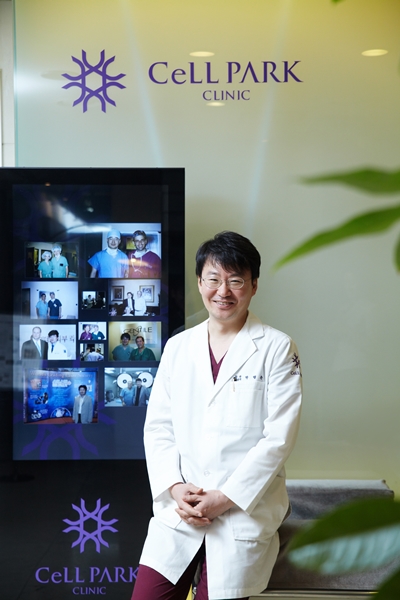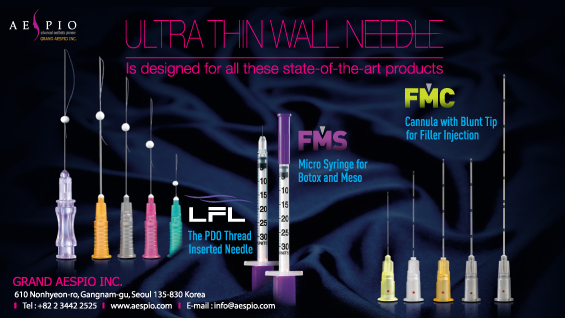Korea’s first dermatologist specializing in aesthetic stem cell therapy
Dr. Byung-soon Park of Cell Park Clinic

Dr. Park’s Cell Park Clinic is Korea’s first aesthetic clinic specializing in stem cell therapy. He was the first aesthetic clinician to integrate the advancements of regenerative medicine and cell therapy into aesthetic treatments. Since its opening in 2013, Cell Park Clinic has maintained its famous cell banking system where young cells are harvested and stored for up to 15 years. The cell banking system is used in dermatologic and hair loss treatments.
Dr. Park has specialized in stem cell therapy for over a decade. He remembers the decade to be rather tumultuous. One of the other doctors performing stem cell therapy charged patients KRW 12 million for one procedure claiming that their fat graft survival rate was over 90%. This doctor was later sued for committing a fraud, damaging the public image of stem cell therapy.
“Other private practices claiming to have the original technology often failed to show the expected efficacy. I had to prove that I pioneered the technology by patenting it but soon found that patents do not always work to your favor. Once the technology is patented, it was to be released to the public. Important proprietary technology should not be publicly shared. I heard that only three people in the world are privy to Coca Cola’s famous cola recipe and the recipe is heavily protected. However, patenting the aesthetic stem cell therapy could not protect its secrecy.”
As a result of various efforts for revitalizing the stagnant stem cell therapy market, the number of patients receiving stem cell therapy has grown. Indications widely vary from scars, wrinkles, melasma, and hair restoration, etc. with the scar and hair restoration treatments gaining in popularity.
“Patient satisfaction is especially high with hair restoration treatment. We combine stem cell therapy with customized hair transplantation and most patients see satisfactory results in three months. Our prices are reasonable. Some think that hair loss treatments have a high margin but the price is determined based on treatment frequency and the margin is similar to other hair treatments.”
[Advertisement] ULTRA THIN WALL NEEDLE – Manufacturer: AESPIO(www.aespio.com)
Dr. Park’s specialty in stem cell therapy has its roots in the Korean Dermatological Association Conference held in 2005.
“Anyone may come up with a creative and innovative idea but it’s difficult to follow through with it. Stem cells were quite an issue around 2004 and I had this idea that stem cell therapy could be combined with aesthetic treatments. But clinical cases of combining the two fields were non-existent in Korea and I did not know how to go about doing that. In 2005, I had the opportunity to attend Professor Kotaru Ushimura’s talk at the Korean Dermatological Association Conference and had a mental breakthrough. Professor Kotaru Ushimura is a stem cell therapy expert who developed CAL (Cell Assisted Life transfer). After his talk, I had the chance to meet him in person and he gave me valuable advice and information on cellular therapy. After meeting Professor Kotaru, I decided to focus my dermatology career on anti-aging, regenerative therapy, and hair restoration rather than fat graft and other invasive procedures.”
Dr. Park founded a biotechnology firm called Prostemics and continued his research. In September 2006, his paper was published in ICAD and he commercialized his technology in 2007.
“At a glance, it seems that it was sheer luck that I met Professor Kotaru Ushimura and was given the right pointers but it was still very difficult to even consider stem cell therapy as a treatment option at the time as the public opinion on this new technology was very negative. This was because Dr. Woo-suk Hwang’s false claims to have cloned human embryos with stem cells. Many associated the term ”stem cell“ with fraud. Therefore, something had to be done to change the public opinion. I tried to do this by publishing as many papers as I could. If I published over 10 papers in prestigious journals, it would give my practice more credibility. I worked with my colleagues in academia to maintain quality of research. The university professors who co-authored the studies with me were Dr. Won-suk Kim, Professor or Dermatology, Ganbuk Samsung Medical Center, Dr. Oh-sang Kwon, Professor of Dermatology, Seoul National University Hospital, Dr. Jong-hyun Won, Professor of Dermatology, Asan Medical Center, and Dr. Hyo-seung Shin, Professor of Dermatology, Dongguk University Medical Center. As I expected, publishing quality papers helped overcome the skepticism surrounding stem cell therapy.”
Dr. Park had a memorable incident in 2007 when he devoted his time fully to research and writing. Dr. Hirotaru Hukuoka, President of Japan Society of Clinical Hair Restoration visited Byung-soon Park in Seoul. Dr. Park remembers this proudly as he had been the recipient of advice from a Japanese specialist but now he was in the position to impart his knowledge to other doctors.
“I was very shocked to find out that Dr. Hukuoka wanted to meet with me. At the time, I was exporting AAPE, a hair restorative substance that we independently developed, to the US. Dr. Hukuoka came to see me because he had used AAPE and found it to be very effective. He said that he tried various therapies including PRP, a widely used method for hair restoration, but found that AAPE was the most efficacious. Dr. Hukuoka and I started to share our scientific discoveries which is still going on today. It is a bit embarrassing but he calls me his teacher. Dr. Hukuoka is focusing on hair loss and currently authors more studies than I do. I find his hard work inspiring.”
AAPE is a key aspect of Dr. Byung-soon Park’s career. Developing AAPE turned the tables around for Dr. Park. He went from a learner to a teacher in the field and was able to publish the world’s very first study on the topic in 2010.
“My study was on the mechanism of action of stem cells or stem cell factors in promoting hair growth. In an experiment, I created water culture of human hairs using AAPE which resulted in definite hair growth. The effect was superior to that of minoxidil, a positive control, in all experiments. In the end, I did not have to advertise AAPE as the results of my studies generated enough publicity. AAPE is currently used in over 300 practices in Tokyo alone. I give regular talks on a decade of clinical data and safety of AAPE at Japan Society of Clinical Hair Restoration.”
Dr. Park’s long-term success in providing aesthetic stem cell therapy is based on his special technological knowhow including Lavisse and Angal Formulation that distinguished his practice from others.
“Transplant survival rates are very important for stem cell therapy. My transplantation method increases the survival rate by about five fold. I plan to take the success I have had in Korea with this special technology to the American market. Another paper of mine is pending publication on an American journal. As stem cells are potentially applicable to various fields and treatments, I continue researching new areas to apply this technology. These days I am looking to integrate tissue engineering.”
Dr. Park expressed his concerns about the future of stem cell therapy.
“The aesthetic market continues to evolve with the introduction of innovative technologies and products. On the other hand, aesthetic treatments using stem cells have not advanced much in the past decade. As this treatment has excellent efficacy and great potential for growth, continuous efforts can bring about revolutionary developments in the next 5-10 years. I am cautiously optimistic that the new technology will be not only commercialized but grow in popularity and even be used in life extending treatments.”
-To be continued-




















